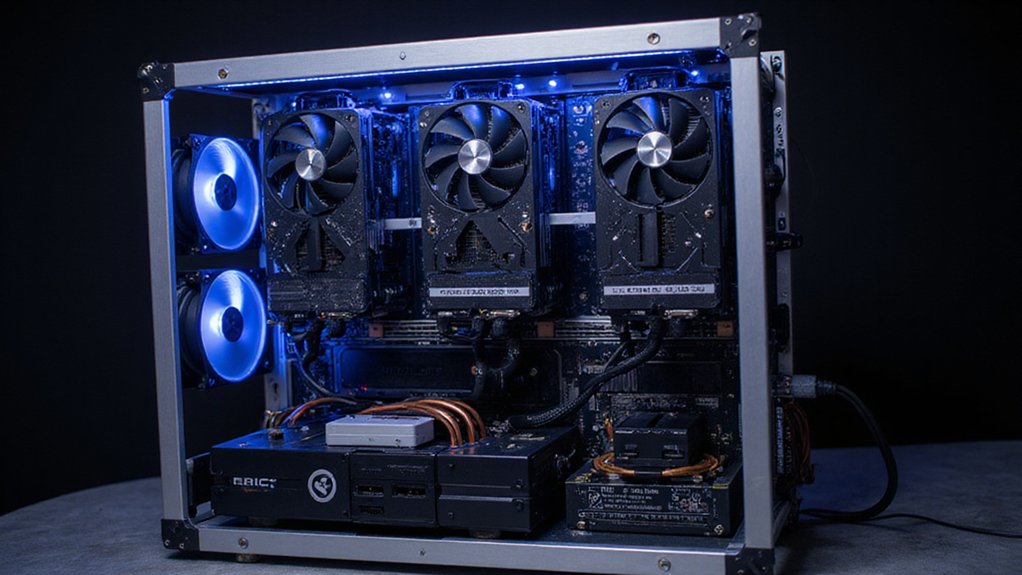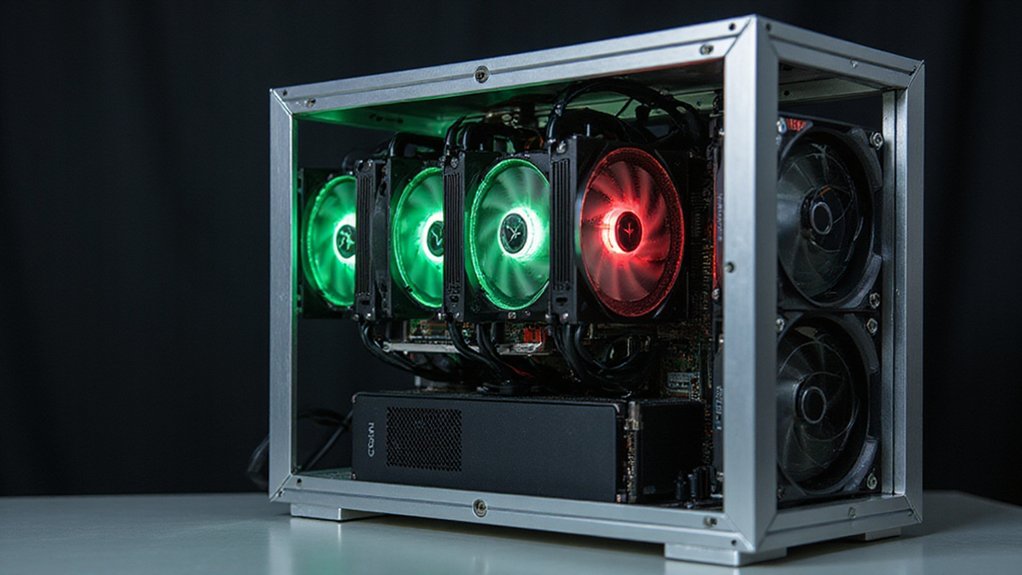Building a crypto mining rig requires assembling specialized hardware designed to solve blockchain puzzles for potential profit. The process entails selecting high-performance GPUs, a compatible motherboard, sufficient RAM, and an oversized power supply unit—all mounted on a frame that facilitates proper airflow. Once hardware is secured, installing mining software completes the transformation of components into a heat-generating, electricity-consuming speculation machine. The subsequent operational realities of noise, thermal output, and electricity costs await those undeterred by the initial investment hurdles.

Why would anyone voluntarily construct a specialized computer system that consumes electricity at alarming rates while generating enough heat to warm a small apartment?
The answer lies in cryptocurrency mining—that peculiar intersection of computing power and financial speculation where dedicated enthusiasts convert kilowatts into digital assets through the solving of complex mathematical problems.
Cryptocurrency mining: digital alchemy where electricity transforms into speculative wealth through computational persistence.
A mining rig, at its core, represents a purpose-built computational array designed to validate blockchain transactions while simultaneously minting new tokens as reward.
The centerpiece of any respectable mining operation invariably consists of multiple high-performance GPUs—the more, the merrier, as hash rate directly correlates with potential earnings (though diminishing returns eventually assert themselves, as with most financial endeavors)¹.
These graphical powerhouses must be supported by a robust infrastructure: a multi-GPU compatible motherboard, sufficient RAM, and—perhaps most critically—a power supply unit with enough capacity to prevent your home’s circuit breakers from expressing their displeasure. For optimal performance and stability, experts recommend a PSU with twice the rating needed for all components combined.
Assembly begins with the frame—a structure providing both physical support and adequate airflow.
Components are then installed methodically: motherboard, CPU, memory, followed by the all-important GPUs, typically elevated via PCIe risers to optimize thermal dissipation.
Once the hardware configuration is complete, an operating system installation provides the foundation for specialized mining software that will orchestrate your rig’s ceaseless computational labors.
Placement considerations cannot be overlooked; these systems generate substantial heat and noise, making well-ventilated locations essential.
Regular maintenance—particularly dust removal—prevents thermal throttling and extends component longevity.
While the initial capital outlay for component acquisition remains substantial, the true operational cost manifests in electricity consumption.
The difficulty of the mathematical puzzles solved by miners is automatically adjusted by the network to ensure a consistent block time, typically targeting new block creation approximately every 10 minutes.
Cloud mining services offer an alternative for those reluctant to transform a portion of their living space into a small-scale data center with its attendant cacophony and thermal output.
It’s worth noting that some cryptocurrencies like Ethereum have shifted to proof-of-stake mechanisms, eliminating the need for energy-intensive mining operations altogether.
¹The mathematical reality that each additional GPU yields proportionally less profit once difficulty adjustments occur.
Frequently Asked Questions
How Much Electricity Does a Mining Rig Typically Consume?
A typical crypto mining rig consumes approximately 1,000 watts or more—comparable to a medium-sized air conditioner—with power draw varying based on hardware configuration (number of GPUs or ASICs deployed).
These electronic workhorses typically operate at 80% utilization continuously, creating substantial electricity demands that, when aggregated across operations, contribute to an astonishing 2.3% of total U.S. power consumption.
The financial calculus proves challenging; electricity costs often determine whether mining ventures remain profitable or become cautionary tales.
Can I Mine Profitably With a Standard Laptop or PC?
Mining profitably with standard consumer hardware is, regrettably, a pipe dream in today’s cryptocurrency landscape.
The economics simply don’t add up—network difficulties have soared while hash rates of laptops and PCs remain woefully inadequate.
Such devices lack the computational muscle to compete with ASIC farms and professional operations, while their inefficient energy consumption virtually guarantees negative returns.
For the average user, electricity costs alone would exceed any potential earnings, rendering the endeavor an exercise in financial self-sabotage.
How Loud Are Mining Rigs During Operation?
Mining rigs typically generate considerable noise—ranging from 70-90 decibels for standard ASIC miners (comparable to a loud restaurant or vacuum cleaner).
This cacophony scales logarithmically; multiple machines don’t merely add but multiply the auditory assault.
GPU setups with custom cooling can operate more discreetly at 30-40dB, while liquid-cooled systems offer further acoustic relief.
Noise mitigation remains essential given potential hearing damage above 70dB and the inevitable community complaints that follow unabated mining operations.
Should I Join a Mining Pool or Mine Independently?
For newcomers to the cryptomining landscape, joining a pool offers both solace and stability—the steady drip of smaller rewards generally outweighs the theoretical jackpot of solo mining.
Unless one possesses industrial-grade hardware (and a remarkable tolerance for variance), the mathematics simply doesn’t favor independence.
The choice ultimately distills to a classic risk-reward calculation: predictable income with modest pool fees versus the improbable, though potentially lucrative, prospect of capturing entire block rewards single-handedly.
What Happens to Mining Profitability After Cryptocurrency Halvings?
Cryptocurrency halvings create a dramatic temporal bifurcation in mining profitability.
Initially, miners face a sobering reality: block rewards slashed by 50% overnight (a financial cliff-edge that would make traditional investors blanch). Hash rates typically decline as marginal operators exit.
However, halvings’ supply-side economics have historically triggered price appreciations that eventually restore—or even enhance—profitability for those miners with sufficient capital reserves and operational efficiency to weather the interim turbulence.









